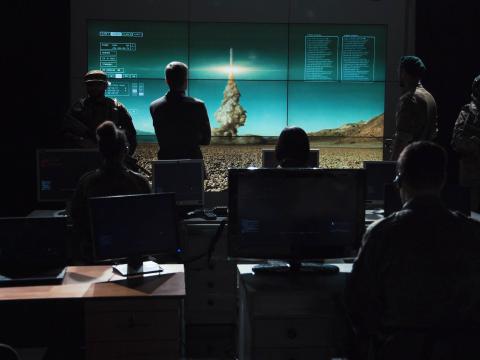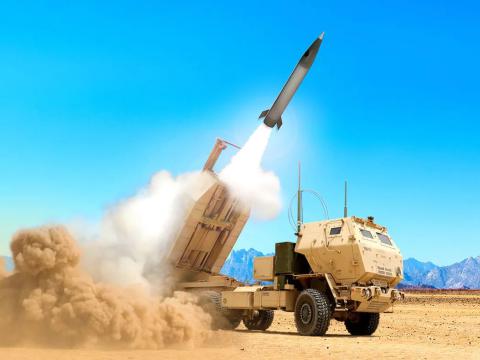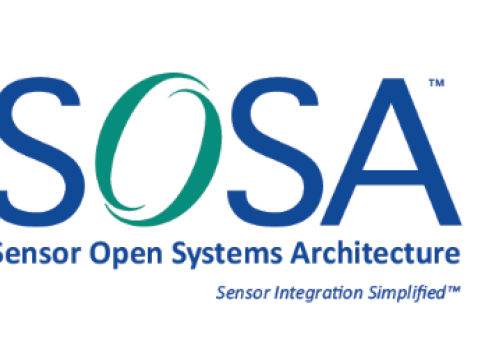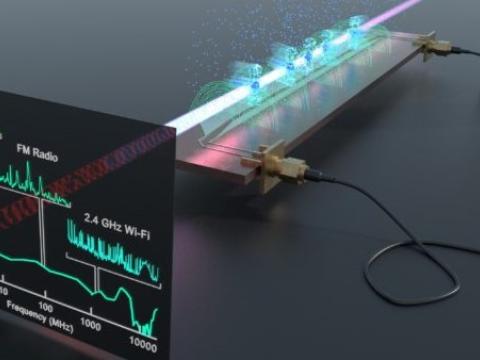Technology Impels Command and Control Changes
Adm. James G. Stavridis, USN (c, l), supreme allied commander Europe and commander of the U.S. European Command (EUCOM), speaks to attendees of the Western European Chiefs of Defense conference at Patch Barracks in Stuttgart, Germany. NATO command and control (C2) often involves 28 alliance nations and other countries working in coalition operations.
The discipline dutifully follows new directions mandated by the dynamism of silicon. 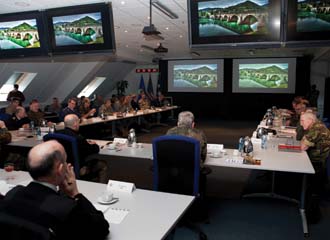
Command and control is undergoing an evolution spawned by the information technology revolution. These changes may be both desired and immutable, as no military commander can either neglect new capabilities or turn back the technological clock when it comes to managing forces in the battlespace.
The changes wrought by information technology over the past three decades are branching out into new areas that parallel the spread of innovation in the private sector. And, just as society is being restructured along the lines of mobile networking, so too is the military changing its command and control (C2) to adjust to new force structures and operational realities.
Adm. James G. Stavridis, USN, is the supreme allied commander Europe and commander of the U.S. European Command (EUCOM). Adm. Stavridis describes the level of change in information technology that he has seen in his naval career as “extraordinary.” He relates that his iPhone currently has better communications capabilities than did his first ship, which was a 1970s Spruance-class destroyer. The small handheld smartphone can enable point-to-point connectivity anywhere in the world, with its ability to tap into the global Internet to provide access to the full information spectrum.
Because that connectivity is so prevalent, commanders are much more engaged in the day-to-day activities than ever before. That comes with advantages and disadvantages, he allows.
The advantages are better visibility, higher speed and flow of information. This helps ensure that subordinate commanders are aligned with their commander and his or her seniors, Adm. Stavridis observes.
A disadvantage is that a commander must avoid becoming “a 10,000-mile screwdriver” just because technology enables it. Subordinates still must be permitted to exercise their leadership, the admiral points out.
“The information technology in the universe of the Internet is not making us dumber,” he states. “We’re able to leverage it in positive ways that allow us to make better decisions.”
Another disadvantage is information overload. With so many pipes feeding data, the deluge of information threatens to overwhelm commanders as well as warfighters. Solving that problem is the next major development coming in information technology, Adm. Stavridis offers.
Filtering that information will require the application of a type of artificial intelligence, he continues. Its development would assist the commander in solving that deluge-of-information challenge. This tool would provide processing, filtration and prioritization of information.
Further down the time line lies the integration of biology and neurology into information technology, Adm. Stavridis predicts. Artificial intelligence will be joined by the direct use of information technology with the human brain. This fusion of information technology and biology is at least 10 years away, but it will revolutionize computational power and change the nature of human society, he says.
C2 is very responsive to changes in technology, the admiral continues, so how an organization exercises C2 reflects its ability to undertake C2. The massive flow of information and the level of detail available at every echelon in the chain of command, along with the speed of information, mandate that an organization adapt by flattening out. This collides with the military perspective of a hierarchical, precise chain of command, he points out.
“What we’re seeing is a world in which commanders have much more information from many different sources,” the admiral says. “They have to integrate that [information], and then use the hierarchical chain of command for execution—even as they are receiving information from a much flatter kind of structure. It’s extremely challenging.”
Adm. James G. Stavridis, USN, speaks to personnel at Spangdahlem Air Base in Germany, from which aircraft supported operations in Libya. The C2 surge needed in the Libya mission is typical for a NATO out-of-area operation, but those surges may become more complex as the flow of data increases across command pipes.
With NATO undergoing a major reorganization, the alliance faces several C2 challenges. Adm. Stavridis notes that NATO’s command structure is being reduced from 11 major headquarters to about six, and the number of command staff is declining from 13,000 to 9,000. He states that these reductions are possible because of the efficiencies introduced by the enhanced C2 capabilities the alliance is now wielding. The alliance is turning to a higher-speed, more capable, streamlined C2 architecture between the centers that will help compensate for the reduction. The process should take about two years, and the reshaping of overall NATO C2 to match the new configuration will be one of the alliance’s biggest challenges. 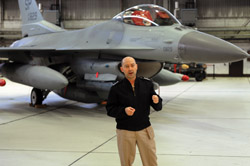
That challenge is organizational. Another C2 challenge is operational. NATO currently is deploying a ballistic missile defense capability across Europe. Known as the European Phased Adaptive Approach Missile Defense System, the new capability combines shipborne Aegis antimissile defenses in the Mediterranean Sea with shore-based TPY-2 radars connected with a C2 structure based in Ramstein, Germany. The Ramstein C2 structure is a U.S. system, and it will be integrated with a NATO C2 system known as the Active Layered Theater Ballistic Missile Defense, or ALTBMD. Connecting these two will be a primary focus of NATO this spring, the admiral reports, and the alliance would like to emplace it as an interim capability by May.
A third C2 challenge is more far-reaching. Adm. Stavridis expresses that the alliance would like to have a better system for monitoring the global geopolitical environment so that it is not surprised by sudden developments such as last year’s Arab Spring. The alliance wants a C2 structure with a centerpiece containing an around-the-clock Comprehensive Crisis Operations and Management Center. That center, which is under construction at Supreme Headquarters, Allied Powers Europe (SHAPE) in Belgium, will help sense the surrounding environment and will connect into the new NATO command structure.
On the cyber front, NATO is emplacing a cyber defense center in its operational headquarters, and it is standing up a cyber policy center in Estonia. Establishing the defense center at SHAPE is a key development for C2 of cyber, Adm. Stavridis allows. This center monitors all NATO circuits throughout the alliance, defends against attacks, and repairs places where intrusions have occurred. It is staffed by experts provided by different nations, he adds.
The NATO Center of Excellence for Cyber Defense in Tallinn, Estonia, will help NATO examine cyber challenges, the admiral says. Estonia has advanced the science of cyber defense after it suffered a cyberattack in 2008, and the NATO facility also features experts contributed by a number of nations. The admiral says that these experts are working through policy questions as they pertain to the alliance.
Among these is the application of NATO’s Article 5, which provides for a common defense if one member nation is under attack. A sticking point in applying Article 5 to the information age is the definition of a cyberattack, so NATO planners are wrestling with exactly what constitutes an Article 5 attack in cyberspace—an intrusion, espionage, manipulation of data, data destruction or action that creates a kinetic effect within or outside of cyber systems, for example. Even when that definition is established, the next step will be to determine an appropriate level of response by alliance members, Adm. Stavridis points out.
Part of NATO’s cyber effort involves outreach to the private sector, he adds. “In the end, cyber must be a private/public cooperative endeavor,” he says. “Everything we touch in the cyber world goes out into the civilian world and comes back into the military world, so it’s insufficient for us to simply defend our own military piece. We must be part of the solution set in the broad sense of defending the societal cyber infrastructure … but where does military responsibility end and government and civilian responsibility pick up?” he posits.
In comparing C2 challenges, Adm. Stavridis notes that he faced two entirely different situations in his billets at U.S. Southern Command (SOUTHCOM) and NATO. Foremost among the differences is scale. SOUTHCOM typically had about 1,500 uniformed military personnel conducting operations at any given time. Emergency responses such as the Haitian earthquake relief effort would surge that total, he notes. NATO, on the other hand, has up to 170,000 military personnel in active operations on three continents.
The two commands’ roles also are different. SOUTHCOM generally engages in partnership capacity building, counternarcotics work, engagement and disaster relief. NATO is involved with warfighting that entails commanding tens of thousands of uniformed personnel. NATO is involved in active combat roles, where SOUTHCOM’s operations range up to training and advising the Colombian military.
And, NATO is the ultimate multinational organization, Adm. Stavridis offers. In addition to the alliance’s 28 nations, NATO works with other countries in a variety of operations. In Afghanistan, 50 nations are part of the International Security Assistance Force (ISAF), and each of the partners has its own distinctive C2 requirements that may parallel the NATO chain of command.
In spite of these differences, both commands have similar C2 surge capabilities, the admiral says. SOUTHCOM needed to add about 15,000 operational forces to help recovery efforts after the Haitian earthquake, and NATO surged about 20,000 people when last year’s Libyan operation began. Adm. Stavridis adds that NATO probably will not need any larger surge capacity than in the Libyan operation. SOUTHCOM’s Haitian surge was fed by U.S. C2 pipes, while the NATO Libyan surge was supported by the alliance’s Joint Force Command (JFC) Naples. The NATO Communication and Information Systems Services Agency (NCSA) built the C2 surge structure—including a 400-person joint task force-type headquarters—that JFC Naples needed for the operation. So, both commands employed extant assets for their C2 surges.
“We have that [C2 surge] capability in NATO, and we have it in U.S. forces,” the admiral declares. “I think it is extremely important that we exercise it, and that we recognize that these kinds of surges are going to come at us.”
